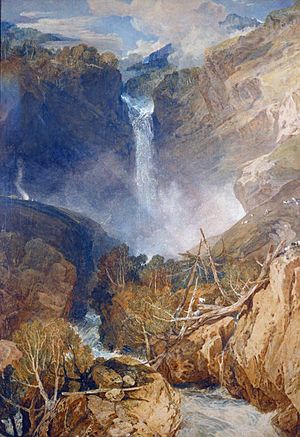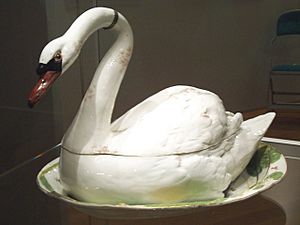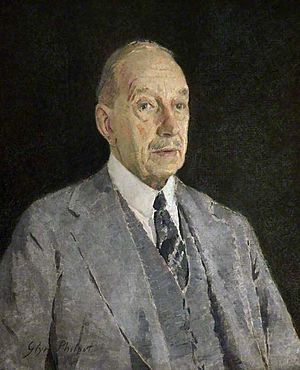- This page was last modified on 17 October 2025, at 10:18. Suggest an edit.
The Higgins Art Gallery & Museum facts for kids

The Higgins
|
|
| Established | 1949 (Cecil Higgins Museum), 1960 (Bedford Museum), 2005 (Cecil Higgins Art Gallery & Museum) 2012 (The Higgins Art Gallery & Museum, Bedford) |
|---|---|
| Location | Castle Lane, Bedford, Bedfordshire, England |
| Type | Art Gallery & Museum |
The Higgins Art Gallery & Museum is a main art gallery and museum in Bedford, England. It is managed by Bedford Borough Council and the people who look after the Cecil Higgins Collection.
Contents
About The Higgins
The Higgins Art Gallery & Museum is located in the Castle Quarter. This area is where Bedford Castle used to be, near the River Great Ouse. The Castle Quarter also has gardens, shops, restaurants, and the John Bunyan Museum. The Higgins museum reopened in June 2013 after a big renovation.
How The Higgins Was Developed
A large project costing £5.8 million helped connect and update the buildings. This brought together three places that were once separate: the Cecil Higgins Art Gallery, Bedford Museum, and Bedford Gallery. The new single building needed a new name. 'The Higgins' was chosen because it was the name of the family who lived and worked there. The Higgins family, including Charles Higgins, played an important part in the town's history.
The museum's development happened in two stages. The first stage finished in April 2009 when Bedford Gallery reopened. This building, which is a Grade II listed building, had not been used since 1973. Reopening it for exhibitions and events gave people an idea of what the second stage would be like.
The second stage of the project joined the three separate buildings. These were Bedford Gallery, Cecil Higgins Art Gallery, and Bedford Museum. This created one large museum and brought all of Bedford's special collections together. Building work started in August 2011 and finished in June 2013. This stage was made possible with money from Bedford Borough Council, the Heritage Lottery Fund, and other groups.
The new museum has spaces for traveling exhibitions and temporary displays. It also has areas for learning and activities, a cafe, and a shop. You can see important collections by the Victorian architect William Burges and the 20th-century designer Edward Bawden in their own special galleries.
History of the Cecil Higgins Art Gallery
The art collections at The Higgins used to be a separate place called the Cecil Higgins Art Gallery. The people who manage the Cecil Higgins Art Gallery still own these collections. The gallery was known for its collections of watercolours, prints, ceramics, and furniture. It also had two of the largest collections of works by William Burges and Edward Bawden outside London.
The Cecil Higgins Museum, as it was first called, opened on July 25, 1949. It was in a house built in 1846. This house was the home of Charles Higgins and his family, next to the Higgins & Sons Brewery.
The museum was created by Cecil Higgins (1856–1941), who was a brewer and a generous person. He wanted to share his collection of ceramics, glass, and art objects. He hoped it would be "for the benefit, interest and education of the inhabitants of, and visitors to, Bedford." Cecil Higgins knew that public museums could be at risk. To protect his collection, he left a detailed will. It explained how the museum should be run. He also left money to be used for the museum, mainly for buying new art.
The original collection of ceramics and glass was very good. However, it did not have many paintings. In 1951, the Art Gallery Board decided to collect English watercolours. Cecil Higgins' will said that all new art had to be approved by an "artistic authority" like the Victoria and Albert Museum. So, experts like Graham Reynolds, Edward Croft-Murray, and Ronald Alley helped choose new artworks.
Between 1952 and 1964, the museum bought many watercolours. Over 500 were added in just twelve years. This was possible because many watercolours from private collections became available after the war. Also, Cecil Higgins' generous fund helped. The museum now has one of the best watercolour collections outside London.
In 1971, the museum started focusing on decorative arts. They bought many pieces from the Handley-Read Collection. The Cecil Higgins Art Gallery now has over 200 items from Charles and Lavinia Handley-Read's collection. They started collecting Victorian art when few people were interested in it.

J. M. W. Turner's 1804 watercolour of the Reichenbach Falls, part of the gallery collection.
From 1988, the museum again focused on collecting prints, especially from the 20th century. The print collection now has over 400 pieces. These include works by famous British artists and international artists like Picasso. The collection shows different art styles and printing methods. A big addition to the print collection was a gift in 2004 from the Scottish artist Alan Davie. He donated over 70 prints and 5 paintings.
Recently, the museum has added works by Dora Carrington. She went to Bedford High School and lived in Bedford. The collection includes two major oil paintings, 'Mrs Box' and 'Spanish Boy'. It also has drawings of her brothers and Bedford Market.
In 2005, the Cecil Higgins Art Gallery joined with Bedford Museum. They kept their separate buildings until they closed for renovation in 2007. The Bedford Gallery was updated first as part of a bigger project. From April 2009 to April 2011, exhibitions from both the Cecil Higgins and Bedford Museum collections were shown there. After the second stage of the project, Bedford Gallery became part of the larger museum building.
History of Bedford Museum
Bedford Museum was created in the 1960s. It combined collections from Bedford Modern School and Bedford Borough Council. Its collections tell the stories of people and places in Bedford. They cover social history, archaeology, natural history, and items from other cultures.
In 1884, a lawyer named Charles Prichard gave his collection of fossils and minerals to Bedford Modern School. He also gave money to create a school museum. Over time, the museum added many unusual items from around the world. People sometimes called it the 'Old Curiosity Shop'.
In the 1920s, P.G. Langdon became the Honorary Curator. He wanted to organize the collections and make them the start of a county museum. He added archaeological items like Roman and Saxon pottery. He also improved the natural history collection. In 1929, two new galleries opened. For the first time, the museum was open to the public on certain afternoons for a small fee. It became known as one of the best school museums in England.
F.W. Kuhlicke, a local historian, became Honorary Curator in 1933. He continued to grow the collections. By the 1950s, the school needed more space. So, discussions began with the Borough of Bedford about taking over the public museum. In 1962, the new town museum opened in a former garage. This was a temporary home.
In the 1970s, the old Higgins and Sons Castle Brewery buildings became available. This large brick building offered more space for public services, exhibitions, and storage. John Turner became the first professional Curator in 1974. He led the work to turn the brewery into the new town museum, which opened in 1981. The museum joined with the Cecil Higgins Art Gallery in 2005. It closed for renovation in October 2010 and reopened in June 2013 as part of the new combined museum.
The museum has about 20,000 items. These show the human, social, and natural history of the Borough of Bedford. They include items from homes, businesses, military, and farming. There are also local crafts and industries.
Bedford Museum's archaeology collections include Palaeolithic flint tools and hand axes. It also has items from Medieval times. The museum has a large collection of coins and medals. The geology collections feature ammonite shells and giant marine reptiles from the Jurassic period. Local birds, mammals, insects, and plants are found in the museum's natural history collections.
History of the Museum Site
The land and buildings where The Higgins stands have a long history. One important event was the Siege of Bedford Castle, which you can read about on the Castle's wiki page.
The current buildings started in 1804 with a Hexagonal Militia Depot. This building was later used as a school and kitchens for the Higgins family home. Since 1949, it has been a gallery, office, and activity space. After the first stage of redevelopment in 2008, it was updated. It now houses the William Burges collection.
In 1837, Charles Higgins bought the lease for Castle Lane. He started building the brewery, which was finished in 1838.
Between 1840 and 1841, the building now called Bedford Gallery was built. It was first used as a clubhouse for a political group. Later, it was used by the Bunyan Meeting as a Sunday School. In the early 1900s, it became a billiard hall. During World War Two, the British Broadcasting Corporation (BBC) is thought to have used it as a rehearsal and recording studio.
After the war, it went back to being a billiard hall. In 1960, it became part of the Cecil Higgins Art Gallery and was renamed Bedford Gallery. It was used for exhibitions until 1973.
After being closed for over 30 years, Bedford Gallery was planned for a £2.5 million renovation. This project created a modern space for temporary exhibitions. It hosted shows while the Cecil Higgins Art Gallery was closed from April 2009 to April 2011. In 2013, it reopened as part of the new combined Art Gallery & Museum.
The lease required Higgins to build a house on the site. Castle Close, the house Charles built for his family, was finished in 1846. Family members lived there until the early 1920s. By the late 1920s, the property was owned by the Bedford Corporation (now Bedford Borough Council). It was used for offices until Cecil Higgins' will suggested it house his collection in 1941. The museum opened there in 1949.
See also
- John Bunyan Museum – a museum about John Bunyan, located near The Higgins.



